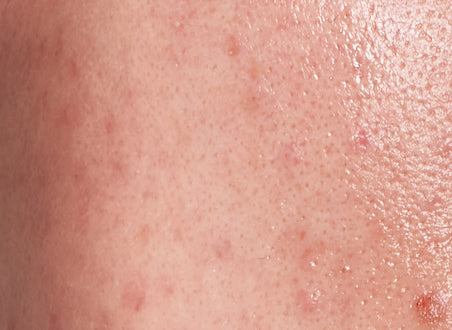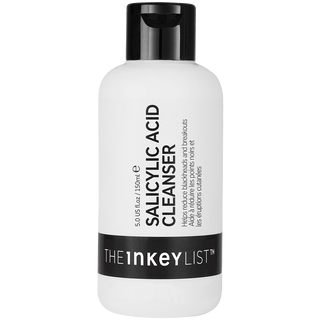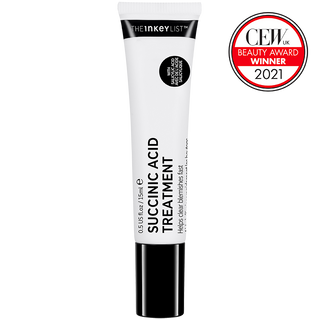Back & chest acne 101

Acne isn’t a condition that just favours the face, it can commonly be found across the body as well, in particular the neck, back, shoulders and chest. If you’re prone to acne and breakouts, it may be more likely you experience this as it’s the same oil producing glands that can be sensitive to hormone imbalances and lifestyle changes that can trigger breakouts.
WHAT IS BODY ACNE
Essentially, acne has the ability to occur wherever there are hair follicles. When it comes to the body, it is most prevalent in areas that get particularly oily such as the centre of the chest and upper back.
B-acne (back acne) and chest-ne (chest acne), work in the same way as facial acne (check out our Acne 101 blog for more) and is the result of clogged hair follicles caused by blockages from excess oil production combining with dead skin cells, dirt and bacteria. Blocked pores can then become inflamed and infected resulting in red aggressive spots on or beneath the skin’s surface - this is known as folliculitis. Certain areas of the body such as the shoulders, chest and upper back have more glands than other areas which is why they tend to be hotspots for, well, spots.
Acne and breakouts are typically triggered by hormones, lifestyle and genetics. Stress can also play a large role in the intensity and healing of spots. Stress hormones can cause the skin to produce more oil but equally, if the body is in a state of stress, the energy to the immune system is depleted making recovery a longer process.
If you’re prone to acne on the face, you are more likely to experience it across other regions too. You can make immediate adjustments to things such as diet, clothing, work out routine which can influence your skin but exploration into the hormonal and genetic impact on your skin can require assistance from a doctor or dermatologist.
Back-ne and chest-ne can be further aggravated from being confined in clothing where friction, trapped bacteria and lack of oxygen can intensify the symptoms and spread of the outbreak - known as dermatitis.
To work out whether your breakout is acne or a reaction, irritation or allergy observe its characteristics. Acne manifests as red angry bumps often containing pus. Irritation or allergic reaction tends to be more flaky, red or itchy. It’s important to find the root of allergies or sensitivity so you can eliminate the cause which can be explored with a doctor or dermatologist if persistent.
HOW TO GET RID OF BODY ACNE
It’s uncomfortable, can be hard to reach and makes us conscious of covering up - so how do we address the body blemishes? Firstly, it’s important to treat your body skincare routine as intensely as your facial skincare routine, calling upon hero ingredients and products.
Luckily, some of the solutions to treating and preventing may already be in your existing skincare routine. Correct, a number of our products can be used on your body as well as the face meaning you don’t have to make room in the bathroom cabinet for more bottles, lotions and potions. When it comes to breakouts, knowing your ingredients can be your most effective way to target. AHAs and BHAs dissolve dead skin cells and dirt lodged in the pores and help eliminate the bacteria that triggers infection. Favoured in our range is Salicylic Acid - the BHA to BFF. It’s a staple for all skincare renowned for clearing pores of excess sebum and build ups whilst exfoliating the skin’s surface.
INKEY back & chest acne heroes:
Salicylic Acid is an essential ingredient when it comes to breakouts. It’s oil-soluble and can reach deep inside the pores, helping to reduce the build up of oil and debris. We use a Zinc compound to help control excess sebum, while allantoin is used to calm, soothe, and protect, irritated skin. With anti-inflammatory and anti-bacterial properties, it can also help spots fade quicker when they do arrive.
HOW TO USE: Salicylic Acid cleanser can be used in the AM and PM. Gently massage a small amount onto dampened skin of the breakout area for at least 60 seconds. Rinse thoroughly with water before continuing your routine.
Succinic Acid is a bio based chemical derived from corn and helps reduce the appearance of blemishes and decrease oils levels in the skin. It can also help reduce acne bacteria on the skin, a usually harmless skin bacteria that can cause inflammatory acne when hair follicles become blocked.
Our targeted treatment contains 2% Colloidal Sulfur which has keratolytic properties which helps to exfoliate and further reduce pore congestion.
HOW TO USE: Can be applied to a blemish up to three times per day. We suggest cleansing with Salicylic Acid Cleanser first. Place a small amount from the tube onto a clean finger and apply directly onto the blemish. Leave the formula to dry for 5 minutes before applying further products or clothing.
Its powerful combination of Vitamin C and Vitamin E, this overnight mask works hard to treat blemishes and prevent future breakouts. Also containing our hero Salicylic Acid, it helps to exfoliate and unclog pores, while Lotus Extract helps to balance oil. On top of this, it also has anti inflammatory and anti redness properties, whilst evening skin tone.
HOW TO USE: Use in the PM as your last step before sleep. Apply a thin layer blemish-prone areas, including your back and chest. Once absorbed, leave to work overnight and wash off the next morning.
PREVENTING BACK & CHEST ACNE
Alongside bringing the best products into your bathroom, there are some other measures you can take to prevent body breakouts.
WEAR LOOSE FITTING CLOTHING
TIght clothing doesn’t allow the skin to breath and can trap bacteria, oil and dirt close to the skin surface making it prime for pimples. Opt for a looser fit where possible and allow your skin to take a deep breath. Friction can also aggravate existing breakouts being preventative in the healing process so this is particularly important for active breakouts.
GO NATURAL
As well as looser fits, opt for natural fibres such as cotton which are more breathable allowing air circulation around the skin. Cotton, silk and linen are naturally hypoallergenic so great if your skin is also sensitive.
BE AWARE OF HAIR
If you have long, luscious locks, this could be a contributing factor to flare ups on the skin when they come into contact. For example, using lots of product on the hair such as oils and conditioners, can mean residues end up on the skin’s surface and cause imbalance. Equally, not washing hair frequently can mean that natural oils also end up on the skin and clog pores.
SHOWER REGULARLY
Dead skin cells and bacteria can build up on the skin throughout the day which is what causes the blockages to the hair follicles when combined with overactive oil production. Regular showers, especially after workouts, helps remove that element from the congestion-forming cycle. Plus a blast of cold water can help to close the pores leaving them less receptive to absorption.
CHANGE YOUR SHEETS
Changing fabrics frequently, such as towels, pillow cases and bedding is highly recommended
as they can be hubs of bacteria, moisture, dead skin which can transfer to the skin’s surface on contact. Plus, a fresh set of sheets is much more satisfying than a fresh set of spots.
MANAGE STRESS
This can be easier said than done, but stress can be detrimental to the body’s healing processes when recovering from infection - whether that’s a common cold or the pus-filled pimples across your chest. Practicing yoga, meditation, walks in nature, reading a book in the bath or any form of self-care can lower cortisol levels meaning your energy is available to beat the breakout bacteria.
GET ADDITIONAL SUPPORT
If you’re not seeing the results or your acne is severe, it may require specialised advice and prescribed treatments. We always recommend consulting a doctor or dermatologist about your acne to investigate external factors that may be impacting your skin and the best mode of treatment for your individual needs.
For further questions, support or to create a tailored acne-busting recipe - contact the team at #askINKEY.











